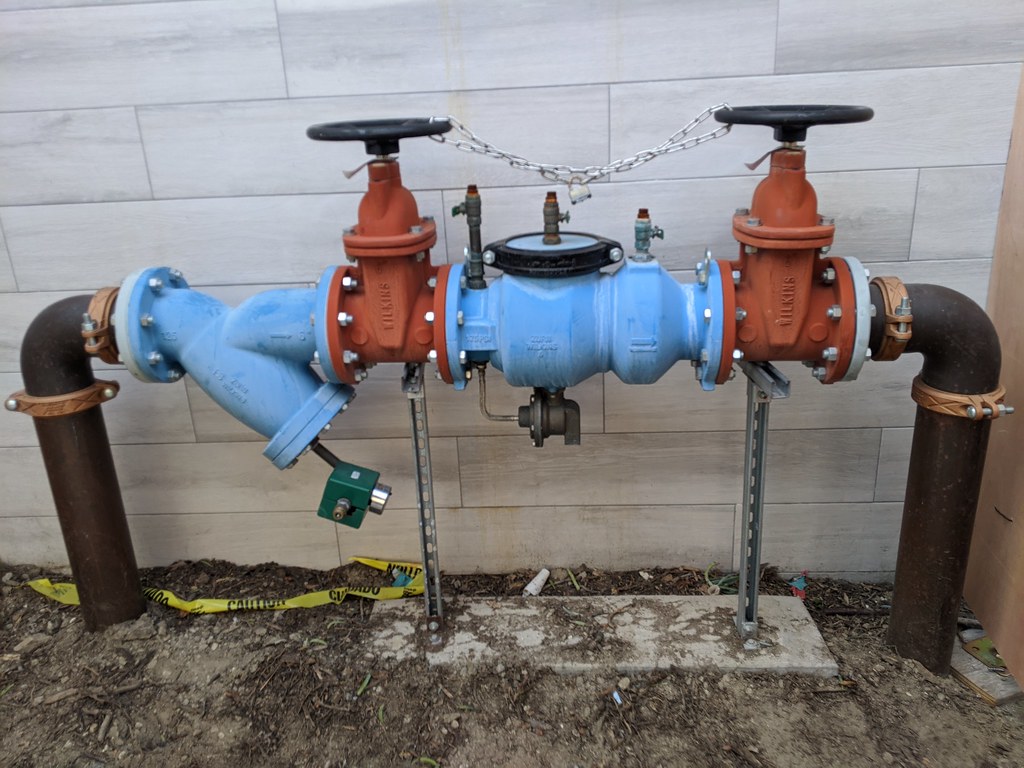
We have come to find that the better educated customers are about what backflow preventers do, the more they understand what they are paying for. On this page we have included some useful information along with pictures and videos that should help understand the basic functions and purpose of a backflow preventer.
What Is Backflow?
Simply put, Backflow is what happens when water travels in the opposite direction than intended. In This case, when non-drinking water travels back through the customer’s water lines and into the county’s drinking water lines. Backflow prevention is very important regarding Florida lawn irrigation systems.
What Causes Backflow?
Most commonly, Backflow happens when the supply line (water supplier) loses pressure, causing back siphonage from the customers lines. Or when the customer has more water pressure in their lines than the supplier, causing backpressure.
Why Does My Backflow Device Have to Be Tested Annually?
Besides yearly testing being the law, there are very good reasons for doing this. The internal parts of a backflow preventer are made of plastic and rubber. Plastic and rubber wear out and break over time.
Because of this it is mandatory by various Central Florida municipality regulations, to have your backflow preventer tested by a certified tester every 12 months to ensure that it is functioning properly and protecting our drinking water.
Here is a link where you can find all the information on the Florida Backflow Prevention Laws.
What Are the Different Types of Backflow Preventers Used in Central Florida?
Reduced Principle (RP) Backflow Preventer
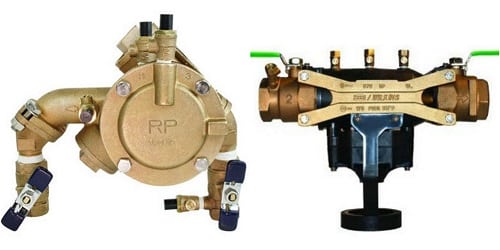
This type of device offers protection against backpressure, back siphonage and is used to isolate health hazards. It offers the best protection against all non-airborne hazards because it has a relief valve that will open and allow non-potable water to drain. Backflow preventers come in different sizes depending on the amount of water and pressure needed for certain applications.
Double Check (DC) Backflow Preventer
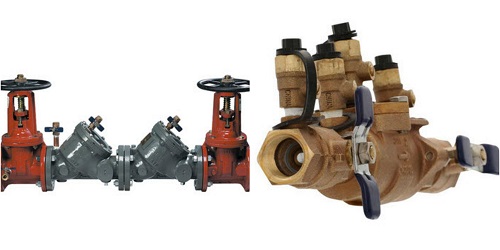
This type of device has the same functions at the RP device, but does not have a relief valve, thus making it not suitable for protection against health hazards. But this is also the only device that can be installed underground, so there are pros and cons to all different types of devices.
Pressure Vacuum Breaker (PVB)
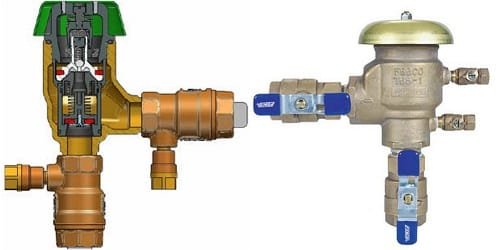
Although no longer allowed in some areas of Florida for new sprinkler systems, they are ubiquitous across the state on older irrigation systems. These provide the least amount of protection. They have the least amount of protection because unlike the DC and the RP, the PVB only has a single check. There is often debris such as pebbles, rust, twigs, etc. that can get caught in the check and hold it open when it should close. This device can protect against health and non-health hazards, but only protects against back siphonage.
Dual Check Backflow Preventer
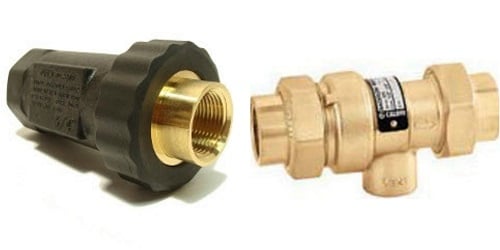
Dual check backflows no longer meet code in both Florida and the city of Orlando and surrounding areas. If it fails, you will need to upgrade to a more sophisticated and code approved device. Knowing whether it has failed can be difficult as they are often buried in the yard near the water meter and not always easy to find.
If you think you may have a dual check backflow because you do not see any others above ground, here is where to look.
Take a 12 inch screwdriver or other probing tool and GENTLY (careful not to poke a hole in a pipe) probe in front of your irrigation meter box. Start probing about one foot in front of the meter box and slightly off to both sides.
What you are trying to find is a buried 6 inch valve box that would contain both the dual check and a gate valve. This how the lawn irrigation turn off was piped long ago. I still find many of these setups especially in the older neighborhoods in Longwood.
How Can I Protect My Backflow Device from Theft?
With the 2021 economy in a tailspin the market for black market precious metals has gone gangbusters. Copper is considered a precious metal to those in the salvage industry and as a result thieves in residential and commercial areas are stealing them to sell for scrap.
They usually cut off backflow devices at ground level by hack sawing the pipes and running off with the entire prevention device ensemble.
Backflow protection enclosures not only help disguise the devices, but they make the process of getting at the assembly much more difficult and time consuming.
Backflow Theft in Central Florida
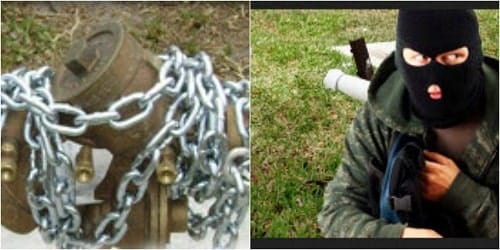
There has been a tremendous amount of backflow thefts taking place in the Central Florida area as well as all over the US. With the rising brass and copper value, thieves and vandals are targeting backflow preventer devices.
Thieves steal these devices for scrap metal. Even the smallest backflow device can bring at least $20 in scrap value. Backflow devices all have serial numbers that can be tracked. Scrap yards are notified by authorities to look out for these stolen devices. But this does not deter disreputable scrap yards from accepting them.
When a backflow device is stolen, it leaves the building with no water until a new device is installed. The cost of having a new device installed is more than double the cost of effective theft protection. If a thief steals your device once, without protection, they will steal it again.
Backflow Protection
The main elements of backflow protection are backflow enclosures or backflow cages. Backflow enclosures are usually made of high-density polymer or fiberglass. Most feature an anti-theft locking system that prevents the enclosure from being opened without a key or combination.
Enclosures
The majority of backflow enclosures consist of a base piece, and a cover that either lifts off or swings to the side so the device can be easily maintained or inspected. These solid encapsulated models provide backflow protection not only from vandals and thieves but also from the wind, which is a major factor in causing pipes freeze.
Metal Locking Cage
Another type of backflow protection enclosure is the metal cage. This variety is usually fashioned with a metal frame and welded steel mesh. The cage is locked and either hinged or just lifted off for maintenance of the enclosed prevention device. The cage type backflow enclosures are more common in industrial areas where aesthetics are not as much of a concern.
A metal locking cage is highly recommended. It offers the best protection against costly theft. A thief won’t even look twice if you have a cage installed over your backflow device. Metal cages come in all different sizes, shapes, colors, and types.
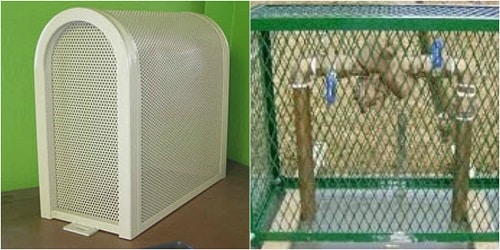
Plastic Locking Cage
A plastic locking cage has a medium level of protection. Although it locks, it can still be broken into or cut open. It is still a deterrent from theft, but if there is nobody around and the thief wants it bad enough, it can be broken into. These plastic cages come in all different sizes, shapes, colors, and can even look like big rocks.
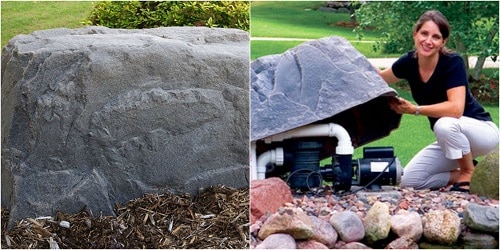
The majority of architects designing for residential and commercial settings opt instead for the polymer (plastic) variety because they are shaped and colored to blend into the natural surroundings and landscaping. Cage type enclosures do not provide any backflow protection from wind or U.V. Rays. Although Central Florida only experiences freezing temperatures every few year, it is still a concern and a plastic cage provides little protection.
Hiding Ugly Backflows
Backflow protection has always been a challenge for architects and homeowners wanting to cover and protect the devices without having to scar the landscape with an awkward looking cage or bulky enclosure.
Recently some manufactures have engineered backflow enclosures using ultra high-density polymers that are highly impact resistant. The enclosures feature elegant curves and subtle colors that blend into the surrounding landscape and do not subtract from a property’s overall curb appeal.
Some are even molded from 100% recycled content and feature U.V. Inhibitors that resist fading in the sun, making them virtually maintenance proof as they will always retain their color and never require painting or refinishing. These types of backflow protection enclosures are becoming increasingly popular.
Fake Rock Enclosures
Backflow protection can also come in the form of a fake rock. Hollow imitation rocks can be used as enclosures over backflow devices in many cases. Some brands of these faux rocks are so realistic they can actually add texture to and enhance a property or landscape.
Just be sure any fake rock enclosure you look at purchasing features a fastening system allowing it be secured to the ground. Hollow rocks large enough to cover a backflow preventer are going to stand quite tall and be an easy target for mother nature’s wind!
Backflow Pads
Another element of backflow protection is the installation pad. The strongest, most durable enclosure in the world will not do much good if it can be easily ripped out of the ground by a thief. Many installations include a solid concrete pad to which the enclosure base is fastened with durable concrete lag screws or concrete anchors.
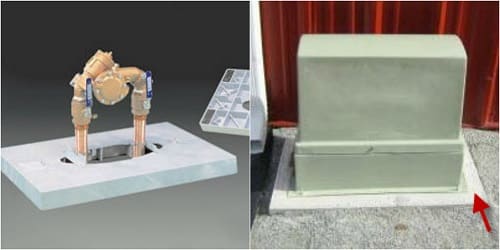
Installations over dirt or grass should include an extra-long spiral staking system that prevents the enclosure from being easily pulled upwards straight out of the ground. For an enclosure to provide solid backflow protection it needs to be well anchored.
Backflow protection can also come in the form of a fake rock. Hollow imitation rocks can be used as enclosures over backflow devices in many cases. Some brands of these faux rocks are so realistic they can actually add texture to and enhance a property or landscape.
Just be sure any fake rock enclosure you look at purchasing features a fastening system allowing it be secured to the ground. Hollow rocks large enough to cover a backflow preventer are going to stand quite tall and be an easy target for mother nature’s wind!
Backflow Protection in Northern Florida Requires Special Attention
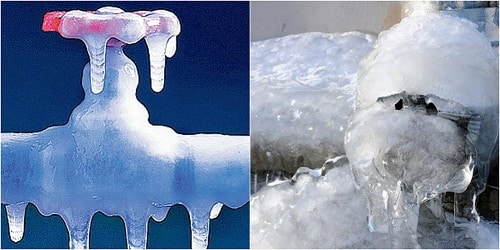
In areas with temperatures dipping below freezing, insulation blankets become part of the backflow protection equation. Backflow insulation blankets, or pouches, are fastened to the device with Velcro or zip ties.
The thermal insulation provides protection from freezing which can lead to frozen and broken pipes. Insulation blankets are much more effective if they are inside of a enclosure with solid sides (not the cage type) so the wind cannot penetrate. In some northern state’s municipalities Class 1 enclosures are specified, requiring R-13 insulation and an electric heat source to provide total backflow protection from freezing temperatures. Recently the need for backflow protection has become an absolute must.
Remember that the most important point is that it is the law backflow testing in Central Florida must be performed once a year to protect our drinking water.



